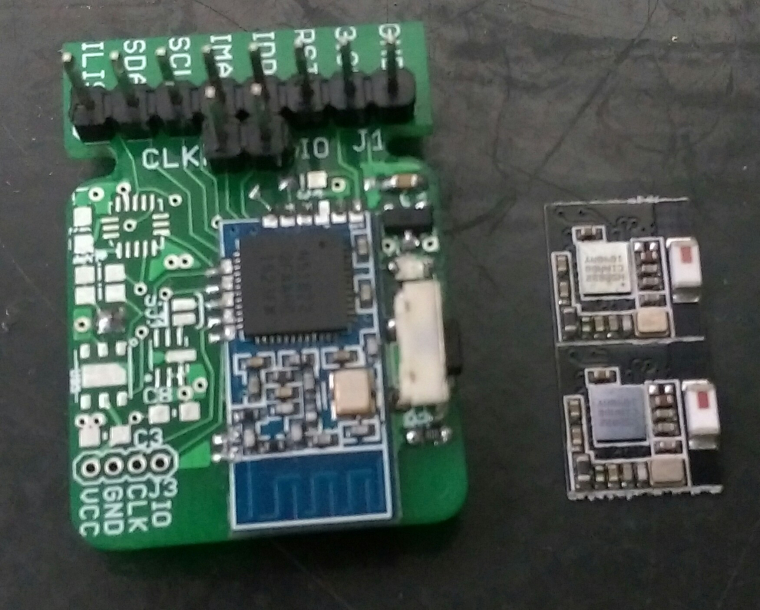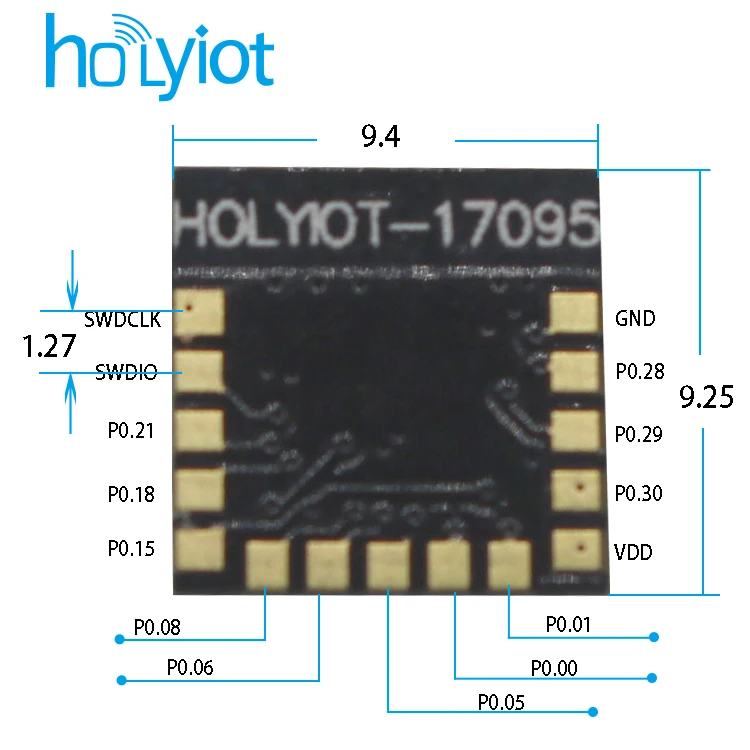nRF5 action!
-
It would probably do well as a "one button scene controller," but is it good for anything else I wonder?
-
I was tempted to try adding the missing accelerometer too, but in the end it's easier and cheaper to make a board with the 2$ module.
-
Speaking of which, I shrunk the HolyIOT board a bit and added the small buzzer:

Hopefully this is small enough that it can be used as a locator beacon.It turns out this is pretty nearly the minimum size, even if the HolyIOT were smaller, because of the CR2032 battery underneath it. Anyway, that's an interesting result, because the BC182 is smaller than the HolyIOT, but I wouldn't get the benefit of it.
-
Speaking of which, I shrunk the HolyIOT board a bit and added the small buzzer:

Hopefully this is small enough that it can be used as a locator beacon.It turns out this is pretty nearly the minimum size, even if the HolyIOT were smaller, because of the CR2032 battery underneath it. Anyway, that's an interesting result, because the BC182 is smaller than the HolyIOT, but I wouldn't get the benefit of it.
@neverdie said in nRF5 Bluetooth action!:
small buzzer:
CR2032 batteryIf I'm not wrong this buzzer needs over 100mA, not sure it's a good match for a CR2032 ?
-
Hi,
Working without problem with mysensors, I use STLink v2 from Aliexpress. LED and Button are mapped on pins 28 and 29 :)
@mika said in nRF5 Bluetooth action!:
Hi,
Working without problem with mysensors, I use STLink v2 from Aliexpress. LED and Button are mapped on pins 28 and 29 :)
Im just reporting sketch from NeverDie ;)
https://www.openhardware.io/view/510/Multi-Sensor-TempHumidityPIR-LeakMagnetLightAccel
-
@neverdie said in nRF5 Bluetooth action!:
small buzzer:
CR2032 batteryIf I'm not wrong this buzzer needs over 100mA, not sure it's a good match for a CR2032 ?
@nca78 said in nRF5 Bluetooth action!:
@neverdie said in nRF5 Bluetooth action!:
small buzzer:
CR2032 batteryIf I'm not wrong this buzzer needs over 100mA, not sure it's a good match for a CR2032 ?
I like how nothing slips past you! Yes, it's a pretty severe trade-off in exchange for its small size. So, I'll be using two CR2032's and make it run only in very short bursts. I honestly don't know how well or badly it will turn out.
-
@nca78 said in nRF5 Bluetooth action!:
@neverdie said in nRF5 Bluetooth action!:
small buzzer:
CR2032 batteryIf I'm not wrong this buzzer needs over 100mA, not sure it's a good match for a CR2032 ?
I like how nothing slips past you! Yes, it's a pretty severe trade-off in exchange for its small size. So, I'll be using two CR2032's and make it run only in very short bursts. I honestly don't know how well or badly it will turn out.
@neverdie said in nRF5 Bluetooth action!:
I like how nothing slips past you! Yes, it's a pretty severe trade-off in exchange for its small size. So, I'll be using two CR2032's and make it run only in very short bursts. I honestly don't know how well or badly it will turn out.
I don't see anything to co trim such a high current on your board ? Maybe it's the reason the sound level is low on your other board, max current of the MCU pin is much lower than what the buzzer needs ?
-
@neverdie said in nRF5 Bluetooth action!:
I like how nothing slips past you! Yes, it's a pretty severe trade-off in exchange for its small size. So, I'll be using two CR2032's and make it run only in very short bursts. I honestly don't know how well or badly it will turn out.
I don't see anything to co trim such a high current on your board ? Maybe it's the reason the sound level is low on your other board, max current of the MCU pin is much lower than what the buzzer needs ?
@nca78 said in nRF5 Bluetooth action!:
@neverdie said in nRF5 Bluetooth action!:
I like how nothing slips past you! Yes, it's a pretty severe trade-off in exchange for its small size. So, I'll be using two CR2032's and make it run only in very short bursts. I honestly don't know how well or badly it will turn out.
I don't see anything to co trim such a high current on your board ? Maybe it's the reason the sound level is low on your other board, max current of the MCU pin is much lower than what the buzzer needs ?
What does "co trim" mean?
-
@nca78 said in nRF5 Bluetooth action!:
@neverdie said in nRF5 Bluetooth action!:
I like how nothing slips past you! Yes, it's a pretty severe trade-off in exchange for its small size. So, I'll be using two CR2032's and make it run only in very short bursts. I honestly don't know how well or badly it will turn out.
I don't see anything to co trim such a high current on your board ? Maybe it's the reason the sound level is low on your other board, max current of the MCU pin is much lower than what the buzzer needs ?
What does "co trim" mean?
@neverdie said in nRF5 Bluetooth action!:
What does "co trim" mean?
Sorry phone rewriting what I type.
"Control".
MCU pins can't source that much current and I see no transistor on your board to do it ?
If you put a reserve capacitor big enough to supply 100+mA long enough to make some sound on the buzzer, will you not fry the pin ? -
@neverdie said in nRF5 Bluetooth action!:
What does "co trim" mean?
Sorry phone rewriting what I type.
"Control".
MCU pins can't source that much current and I see no transistor on your board to do it ?
If you put a reserve capacitor big enough to supply 100+mA long enough to make some sound on the buzzer, will you not fry the pin ?The present design uses a TPS22860 load switch to turn on and off the buzzer. I'm not trying to power the buzzer directly from one of the nRF52832 pins, because the current would be outside the maximum limits for the nRF52832 pin. I'm hoping the two CR2032's will give enough headroom that the voltage (after the LDO) will be stable.
-
The present design uses a TPS22860 load switch to turn on and off the buzzer. I'm not trying to power the buzzer directly from one of the nRF52832 pins, because the current would be outside the maximum limits for the nRF52832 pin. I'm hoping the two CR2032's will give enough headroom that the voltage (after the LDO) will be stable.
-
I received the "holyiot" modules and they are really, really tiny. 2 attached together are exactly the same size than the 51822-04 module. WL-CSP package is very impressive: small, very thin and with a cool shinny surface.
This module has inductors for DC/DC mode, and pins .00 and .01 are mapped so it's possible to add low frequency crystal for Bluetooth mode.

@nca78 said in nRF5 Bluetooth action!:
I received the "holyiot" modules and they are really, really tiny. 2 attached together are exactly the same size than the 51822-04 module. WL-CSP package is very impressive: small, very thin and with a cool shinny surface.
This module has inductors for DC/DC mode, and pins .00 and .01 are mapped so it's possible to add low frequency crystal for Bluetooth mode.

Have you tried uploading anything to the HolyIOT modules? I've now tried on two different HolyIOT modules, both without success. :(
-
@nca78 said in nRF5 Bluetooth action!:
I received the "holyiot" modules and they are really, really tiny. 2 attached together are exactly the same size than the 51822-04 module. WL-CSP package is very impressive: small, very thin and with a cool shinny surface.
This module has inductors for DC/DC mode, and pins .00 and .01 are mapped so it's possible to add low frequency crystal for Bluetooth mode.

Have you tried uploading anything to the HolyIOT modules? I've now tried on two different HolyIOT modules, both without success. :(
@neverdie said in nRF5 Bluetooth action!:
Have you tried uploading anything to the HolyIOT modules? I've now tried on two different HolyIOT modules, both without success. :(
Sorry not yet, I've just re-plugged my NRF5 board and I'm figuring out how to program external board. I'll do it with a board I know works, then try the holyiot module;
-
@neverdie said in nRF5 Bluetooth action!:
Have you tried uploading anything to the HolyIOT modules? I've now tried on two different HolyIOT modules, both without success. :(
Sorry not yet, I've just re-plugged my NRF5 board and I'm figuring out how to program external board. I'll do it with a board I know works, then try the holyiot module;
@nca78 It's a tricky module to solder (probably the most tricky of them all that I've tried so far), so to eliminate that concern on the second module I flipped it over and soldered wires directly to the four essential pads. That way I could visually confirm that it was soldered correctly. Still fails. So, just FYI.
-
@nca78 It's a tricky module to solder (probably the most tricky of them all that I've tried so far), so to eliminate that concern on the second module I flipped it over and soldered wires directly to the four essential pads. That way I could visually confirm that it was soldered correctly. Still fails. So, just FYI.
I think I see the problem. These pinouts are inconsistent:


I had been basing it on the first one, whereas I'm now guessing that the second one is probably the correct one.
-
I think I see the problem. These pinouts are inconsistent:


I had been basing it on the first one, whereas I'm now guessing that the second one is probably the correct one.
Confirmed. That was the problem. Using the second pinout, it now uploads.
-
I have the HolyIOT blinking an LED and receiving packets now. Range, as I suspected, is rather mediocre, but that's probably an inherent trade-off for its small size. For my purposes I don't think it will matter.
-
I have the HolyIOT blinking an LED and receiving packets now. Range, as I suspected, is rather mediocre, but that's probably an inherent trade-off for its small size. For my purposes I don't think it will matter.
-
@neverdie was the difference that they were mirrored along vertical axis? Or am I missing a difference in labelling?
@mfalkvidd said in nRF5 Bluetooth action!:
@neverdie was the difference that they were mirrored along vertical axis? Or am I missing a difference in labelling?
Yes, in the first picture the pin labels should have been mirrored, but weren't. Or, to put it your way, they were mirrored from what they should have been. Either way, it's just wrong.
The second picture is the correct one.
-
Anyone heard anything about when the nrf52840 might be released? I had thought we'd have heard something by now. Surely sometime in 2018 at least? What's the nearest competing chip?
